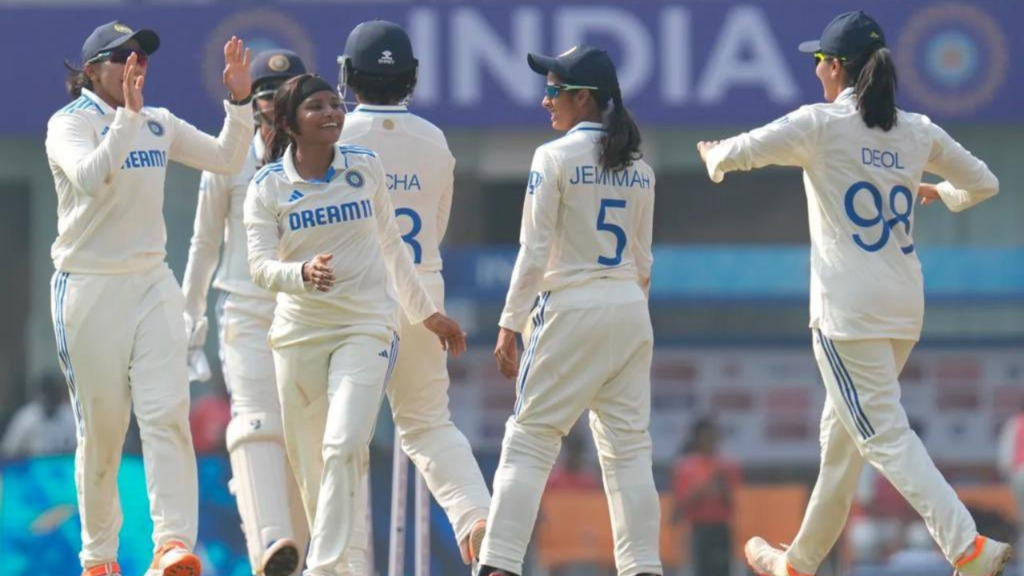
In a rare moment in women’s cricket, India hosted a women’s Test match Test match after nine long years. The move, although widely welcomed on social media, failed to manifest the same buzz in the stadium. The stands at the DY Patil Stadium remained eerily empty even as India women trounced England in the one-off Test match.
India, having won the toss and decided to bat first, took up the challenge head on. Day 1 and 2 of the match were action-packed as the Indian batting line-up lit up the field with red-hot performances. The scoreboard looked something like this – Satheesh Shubha (69), Jemimah Rodrigues (68), Harmanpreet Kaur (49), Yastika Bhatia (66), Deepti Sharma (67) and Sneh Rana (30), as India racked up a huge 428-run total. By the end of day 2, the Women in Blue already led by 478, and what followed after the overnight declaration was nearly a formality.
Looking at the Test game through the lens of men’s cricket, many had assumed – in this new-age of fast-paced, short-form cricket, mushrooming franchise leagues and shrinking attention spans – that the oldest format would simply wither away. But throughout the years, Test cricket has garnered worthwhile attention, especially in India. That following has only increased after the Virat Kohli-led Indian Test side turned into an in-your-face, take-you-to-the-cleaners sort of team. It was something Indian Test cricket had never seen before and it piqued interest.
Stat Alert 🚨
Most Test Wins in the last 10 Years in Women’s Cricket:
INDIA : M: 5 | Won: 3 | Lost: 0
AUS: M: 7 | Won: 2 | Lost: 1
ENG: M: 10 | Won: 1 | Lost: 3
SA: M: 2 | Won: 0 | Lost: 1#INDvENG
📸 @BCCIWomen pic.twitter.com/5nVtRoNn2C
— RevSportz (@RevSportz) December 16, 2023
Greg Barclay, the International Cricket Council (ICC) chairman, however, painted a bleak picture for the future of Women’s Test Cricket. Barclay, who explained how even bilateral series have to be “squeezed” into the calendar with the expansion of franchise leagues, said it was difficult to imagine women’s Test cricket being “part of the landscape moving forward”. Addressing the issue in June 2022, he said it was especially difficult to sow the seeds of Test cricket when national boards did not have a proper domestic first-class structure.
Take India, for instance. The last time a red-ball event was played in Indian women’s domestic circuit was back in 2017 – the inter-zonal three day and the U19 two-day tournament. At the club level, a lot of red-ball games are played. Just don’t mind the fact that they are 20-over matches being played with a red-ball because the clubs usually don’t want to go out of their way to buy brand new white balls or give out coloured jerseys to the girls’ teams (*side eye*) – I speak from experience.
For More Sports News Click Here
On a more serious note, the BCCI has made waves when it comes to promoting women’s cricket, be it the Women’s Premier League (WPL), match-fee parity or more emphasis on the Under-19s.
Going back to the point Barclay was making, we can make him a villain all we want but he had a point. It’s easy for countries like India, Australia and England to host a Test match or series, whereas countries like the West Indies or the associate nations would not have the resources to do so without burning a big hole in their pockets. And it was a telling sign that people did not show up to watch this one-off Test between India and England.
Harmanpreet Kaur, India’s skipper, has been incredibly vocal about the need for more domestic red-ball fixtures. In the current FTP (2022-2025), the Indian Women’s Cricket Team will play the fewest Test matches among the four countries – Australia, England, India and New Zealand.
Even if BCCI does take into consideration Harmanpreet’s plea for domestic tournaments in the longest format of the game, where does it lead? If the ICC Chairman himself isn’t too optimistic about the future of women’s Test cricket and has implied that there will be less than a handful Test matches in the upcoming cycle, what are we all hoping and praying for?
At the end of the day, we all want women’s cricket to grow stupendously, but at the same time, commercial success plays a pivotal role in steering the course of action. In conclusion, this Test between India and England was a reflection of the state and future of Women’s Test cricket. The stands may have been empty but the resolute performances on the field painted a vibrant picture of skill and determination. However, there looms a question mark over the destiny of women’s red-ball cricket. After all, there are few things louder than empty stands and silence.
Also Read: Deepti Sharma stars as India register thumping 347-run win over England in Navi Mumbai



